MARKET OVERVIEW
A strainer filter is a mechanical, practical tool designed to filter out unwanted debris, particles, and impurities from liquids or gases. It simply guides the flow through a mesh or perforated material, capturing unwanted materials while allowing desired fluid or gas to pass through. This simple yet efficient mechanism has been widely adopted in a variety of industrial settings to serve as an essential part of maintaining the quality and safety of operations.
In water treatment plants, for example, strainer filters are vital. They filter out sediments and contaminants in water, thereby helping the water to move on for further processing or distribution. Without such a device, the whole system might experience blockages or inefficiencies, thus resulting in higher maintenance costs or low quality of water. The same is true for strainer filters in HVAC systems. By preventing debris from getting into essential components, such as compressors and pumps, filters help ensure a well-functioning and long-lived system.
In chemical processing, strainer filters are just as essential. They keep the chemicals used in the production free of impurities, which would otherwise react negatively and pose a risk to the entire process. This ensures not only a quality product but also fewer risks and hazards associated with operation. The use of strainer filters also supports compliance with regulations that call for strict observance of safety and cleanliness standards.
The simplicity of the design is what makes a strainer filter so effective. It usually consists of a housing unit that contains the filtering mesh or perforated material. The flow enters the housing, and the filter traps unwanted particles while letting the cleaned liquid or gas continue on its path. Depending on the application, these filters can be made from materials like stainless steel or durable plastics, which offer resistance to corrosion and wear.
Regular maintenance of strainer filters is necessary for ensuring efficiency. With time, debris can collect in the strainers, which may result in decreased flow rates or clogging. Cleaning or replacing the filters at suitable times helps maintain their performance and increases their life span. Overall, strainer filters are a reliable and straightforward method of improving the purity and efficiency of industrial processes, thereby being highly valuable in numerous applications.
Global Strainer Filter market is estimated to reach $5,256.3 Million by 2031; growing at a CAGR of 4% from 2024 to 2031.
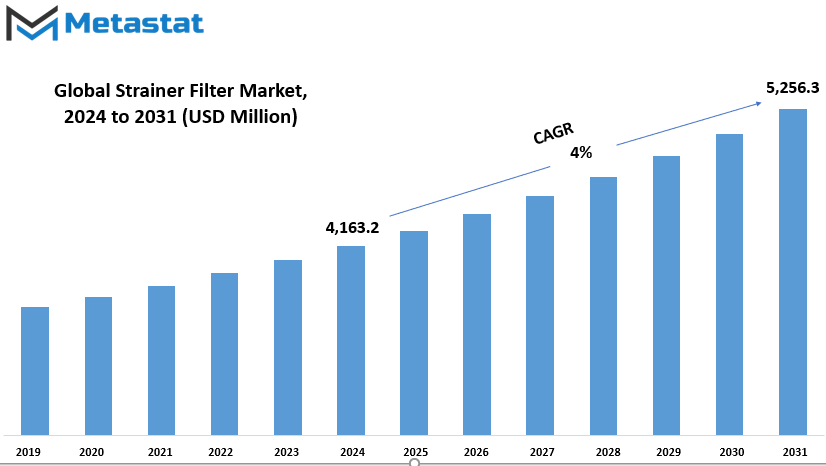
MARKET DYNAMICS
The growing need for clean water and effective wastewater treatment propels the demand for filtration systems. When industries such as oil and gas and chemical manufacturing expand, the urgency of a good filtration system becomes even greater. Both sectors depend extensively on filtration for the efficiency of their operations and compliance with environmental requirements. The need for proper filtration will continue to grow as the industries expand, especially as it grows in importance through greater awareness of sustainability and minimal pollution of water. Such increasing demand for clean water relates to better filtration solutions directly in order to ensure better water quality in industrial processes and also in public consumption.
Still, the market does pose certain challenges. The primary challenge is that the running and maintaining cost of filtration systems is too high. Filters need to be cleaned or replaced quite often, and these expenses add up in terms of operation. For businesses dealing with filtration systems, such expenses are a significant burden. The other challenge with traditional methods is that they fail to filter particles that are too fine. More advanced technologies also present a higher degree of accuracy in filtration, but these require an initial investment that may complicate matters for companies that are looking to optimize their filtration process.
However, challenges remain and there is still an opportunity for growth in this market. The recent improvement of materials and automation has brought ways of improving the performance of the filters and their longevities. For example, better materials make strainers more efficient while automation can reduce labor in cleaning and maintenance to lower overall operating costs. A filter that can be designed to last longer without performance degradation is expected to lower overall operating costs by much. These improvements in the efficiency and lifespan of filters would revolutionize the market as firms would get more affordable alternatives that fulfill their requirements for both pure water and wastewater treatment.
Overall, while the demand for clean water and industrial need for filtration systems are key drivers in the growth of the market, high operating costs and less efficient filtration still pose a challenge. However, improvement in filter materials and automation presents exciting possibilities, promising to improve efficiency and the duration of filtration systems. Therefore, these improvements are likely to open up new opportunities within the market that will yield sustainable and cost-effective filtration in the future.
REPORT SCOPE
By Type
One of the most common types is the Y-Strainer, named after its shape, which allows it to trap debris effectively while being compact in design. Y-Strainers are commonly used in applications that require high pressure and are particularly useful in steam systems. Another variation is the T-Strainer, which also gets its name from its appearance. This type is known for its simple structure and effectiveness in filtering larger particles in systems where frequent cleaning is necessary.
For more demanding processes, Duplex Strainers are the ideal solution. They have two filtering chambers, so one side can be in operation while the other is cleaned or maintained. This means that operations will not be interrupted, making them valuable in critical systems. Basket Strainers are perfect for capturing larger debris. Their deep, basket-like design provides ample space for filtration, making them suitable for water, oil, and chemical applications.
Temporary Strainers, the other variant is used often during commissioning of a system. These are installed in such locations as to catch the debris from newly installed equipment or pipelines in such a manner that the system will break up cleanly. The last one is Automatic Strainers that brings innovation to the process by employing automated cleaning mechanisms. These are suited for applications where it would be impractical to clean manually and provide consistent performance without constant supervision in the process.
Each type of strainer has a specific purpose, so it contributes to the whole reliability and performance of the industrial systems. The right kind of strainer for a certain application can ensure optimal function and long life of the equipment. These devices may be simple, but their role in maintaining the health of complex systems is crucial. With this adaptation to various requirements, strainers can be seen as an indispensible part of modern operations that protect machinery and allow processes to function without disruption.
By Material Type
Options, as industrial materials, make up this market and cater to different needs and applications. In terms of material type, the market for industrial materials can be segmented into stainless steel, cast iron, carbon steel, plastic, bronze, and alloy steels. Each material comes with different properties and benefits, thus being valuable in different industrial and commercial contexts.
Stainless steel is an ideal material that is corrosion resistant, hence its application in areas where moisture or chemicals are exposed. It also has the property of being very durable and aesthetically pleasing, hence commonly applied in construction and household items. Cast iron, on the other hand, is highly recommended for its high heat retention and wear resistance properties. It is highly applied in heavy-duty operations such as pipes, machinery parts, and cookware. Its strength and pressure susceptibility make it essential in industrial settings.
Carbon steel is another popular material due to its strength and affordability. It can be adapted for various tools, building material, and parts of vehicles. Carbon addition to the steel material increases its hardness and toughness; thus, it is used in industries where strength is required for the materials. The second category includes the lightweight plastics offering impressive strength and flexibility. Due to low production costs, a wide usage in packaging, medicine equipment, and consumer good is attributed to it.
Bronze is an alloy of copper and has a high degree of conductivity as well as a high resistance to wear and tear. It is commonly used in applications where friction must be controlled, such as in bearings, gears, and marine equipment. Alloy steels consist of combining various metals for enhancing certain properties such as strength, resistance to wear, or heat tolerance. These are designed for use in industries that demand high performance in aerospace, automotive, and construction.
Each material has its niche in the market, carved out for it, based on property, performance, and compatibility with the conditions. While choosing them, the industry gets to balance factors like price, durability, and functionalities. The diversification of these materials ensures that industries can make suitable solutions for a high range of challenges, which supports growth as well as innovation across any sector. Understanding the different roles and benefits of these materials helps industries make informed choices, ensuring efficiency and reliability in their operations.
By Mesh Size
The main types of the mesh size are categorized into three groups: Fine Mesh, Medium Mesh, and Coarse Mesh. Each of these categories serves a purpose and is regarded as having an advantage over others with different application requirements. A fine mesh is suitable for filtering smaller particles or substances that require high precision, such as in pharmaceuticals or food processing and certain laboratory applications. This mesh type allows the capture of the tiniest particles, thus making it valuable for those industries to maintain precise quality standards and ensure purity in their products.
The medium mesh, on the other hand, is versatile in nature. This can be said since it balances fine filtration with coarse filtration. It is used in such industries as mining, agriculture, and building structures where the material to be filtered is neither of an extremely small nor extremely large size. The medium mesh provides proper filtering capacity to separate materials of different sizes but allows for a good passage of materials. It is therefore adopted in applications where moderate levels of filtration are required without resulting in a loss in efficiency.
Coarse Mesh is utilized in instances where larger particles need to be filtered or sorted. It usually is used in applications that involve the processing of bulk materials, such as gravel, sand, or larger grains. Coarse mesh is ideal for industries that need to separate larger particles from smaller ones or where the finer details of filtration are not as critical. It does not slow the process down as much because it allows for faster processing, unlike finer meshes.
These come in three types, namely Fine Mesh, Medium Mesh, and Coarse Mesh. These are all important in many industries for exactly different needs: the former is used for fine filtration, and the latter for coarse materials. Depending on the need of the procedure involved, the mesh size is determined to be either fine or medium or coarse. The market evolves further as industries demand more specialized solutions to meet their needs. It is, therefore, that the mesh size categories play a critical role in making sure the right mesh is applied for the right application; it makes a significant impact on efficiency and effectiveness in many processes.
By End-User Industry
The global strainer filter market is growing across various industries because of its critical role in the enhancement of operational efficiency and smooth process flow. In the oil and gas industry, strainer filters are used to remove debris and other contaminants from pipelines and equipment. These filters protect sensitive components from damage and ensure smooth and efficient operations. Filtering solid particles from fluids is critical for the performance and longevity of machinery, so strainer filters are a crucial component in this industry.
The water and wastewater treatment industry also derives major advantages from strainer filters. This particular type of industry helps to remove large particles and debris in water to leave it clean before further treatment is performed or to pass it back into the environment, hence ensuring that the latter is kept clean and safe enough for consumption or ecological balance. More important, strainer filters remain a critical factor in maintaining treatment plants' efficiency and ensuring the same quality standards for water products.
The main application of strainer filters is in the chemical and petrochemical industries, where chemicals must be protected against contamination and industrial equipment. Inasmuch as no particulate matter is present within them, the production processes have no qualms about quality or failure; hence, maintenance costs as well as the overall process efficiency are reduced.
The power generation industry depends on strainer filters to ensure that no debris in cooling systems, boilers, and turbines affects their performance. This is realized through the filtering of particles from water and other fluids that will keep equipment operating at peak efficiency and minimize downtime that would be costly to replace.
The strainer filters used in the food and beverage industries separate contaminants from ingredients and liquids. With this, the final product shall be of good quality and, therefore, safe to use. This maintains hygiene in the production line and keeps unwanted particles from entering, and thus, it will offer higher-quality products with high consumer satisfaction.
Strainer filters are one of the different types of filters that ensure that pharmaceutical drugs and products have no contaminants because the pharmaceutical industry requires strict quality for everything processed in their factory.
The strainer filters remove the fibers, dirt, and other small particles from the liquids used for the paper-making process in the pulp and paper industry. It contributes to the quality of the final product and causes less interruption during operations.
All these industries depend on the performance of strainer filters for smooth operation, low maintenance cost, and quality attainment. The more the demand for efficiency, the more the market for strainer filters will grow to serve multiple needs of various industries.
|
Report Coverage |
Details |
|
Forecast Period |
2024-2031 |
|
Market Size in 2024 |
$4,163.2 million |
|
Market Size by 2031 |
$5,256.3 Million |
|
Growth Rate from 2024 to 2031 |
4% |
|
Base Year |
2022 |
|
Regions Covered |
North America, Europe, Asia-Pacific Green, South America, Middle East & Africa |
REGIONAL SEGEMENTATION
The Strainer Filter market has been categorized based on geography so that it is understood how it spans and spreads in different parts of the world. The worldwide market is divided into five main regions: North America, Europe, Asia-Pacific, South America, and the Middle East & Africa. Under each of these regions, sub-regions exist, which largely influence market trends and consumer behavior.
North America further segments the market into three countries: Canada, Mexico, and the United States. The U.S. has always been one of the dominant areas in this region, mainly attributed to the advancement of both its industrial and manufacturing sectors besides having a high demand for filters. Similarly, Canada, as well as Mexico are on their growth path by virtue of increased industrial activities.
Europe, another important region, consists of key countries such as the UK, Germany, France, and Italy. The rest of Europe is also included in this category, covering several smaller but significant markets. Germany, known for its robust manufacturing industry, along with France and Italy, are expected to drive the demand for Strainer Filters in the region. The UK's increased interest in technological development and environmental policies will also be a significant factor in determining the market.
Asia-Pacific, which accounts for a significant portion of the global market, has the Strainer Filter market segmented into countries such as India, China, Japan, and South Korea. The fast industrial growth and increasing infrastructure in India and China will fuel the market in the region. Japan and South Korea-the two technologically advanced countries with a constant demand for high-quality filters-will continue to be mainstays of the growth of the market. The remainder of Asia-Pacific, including the likes of Indonesia, Thailand, and Malaysia, round out the rest of this growth.
South America is another major area for the Strainer Filter market. The countries covered under this region are Brazil, Argentina, and the rest of South America. Brazil, with its burgeoning industry, will be the big contributor, while Argentina and the rest of the South American nations will play a supplementary role in the expansion of this market.
Finally, the Middle East & Africa region is segmented into the GCC countries, Egypt, South Africa, and the rest. The GCC countries, in particular, are known for oil and gas industries, so strong demand for filtration systems can be expected. Egypt and South Africa, as well as other parts of the region, will contribute to the market growth in this area.

COMPETITIVE PLAYERS/ COMPETITIVE LANDSCAPE/ KEY PLAYERS/MARKET LEADERS
The Strainer Filter industry has an important role in several sectors that ensure smooth operations, eliminating system malfunctions due to poor fluid, gas, or other material filtration. Such a field is characterized by key players who are known for their innovation and strong market presence. Among these major players are Parker Hannifin Corporation, Eaton Corporation, and JMF Filters B.V., all of which provide high-quality filtration solutions to meet the diverse needs of their customers.
Other influential companies include Alfa Laval AB and Filter Solutions Inc, which offer an assortment of filtration products with a focus on improving the efficiency of systems and extending the lifespan of equipment. These companies focus on research and development with constant improvement of their products, enabling them to be abreast of the needs of industry. Similarly, Activeline Engineering and Filtration Group Corporation leads the way in producing complex technologies in filtration, providing various industries with manufacturing needs, including water treatment.
Crane ChemPharma & Energy, Kitz Corporation, and Amiad Water Systems also significantly contribute to the industry through specialized strainers and filters used in a variety of applications. Their products are reliable for use under challenging conditions. Scientific Devices (Bombay) Pvt. Ltd. and Hayward Flow Control Systems have also become known for their dependable filtration solutions, especially in water and wastewater treatment.
Jomar Valve, Rosedale Products, and Swagelok Company are also leaders in the industry, providing innovative strainer filters that prevent damage to vital systems by catching unwanted particles efficiently. These companies focus on making the systems they serve more reliable and safe, making them critical in the industrial world. Other notable players in the market include BONOMI INDUSTRIES S.r.l., Boedon Industech Limited, and Filtcare Technology Pvt. Ltd., and also advanced filtration solutions tailored to the needs of their customers.
Collectively, these key players contribute to the growth and development of the Strainer Filter industry through products that help improve operational efficiency, ensure system safety, and meet evolving needs of various industries. The companies continue to innovate and pay attention to quality, shaping the future of filtration technology.
Strainer Filter Market Key Segments:
By Type
- Y-Strainers
- T-Strainers
- Duplex Strainers
- Basket Strainers
- Temporary Strainers
- Automatic Strainers
By Material Type
- Stainless Steel
- Cast Iron
- Carbon Steel
- Plastic
- Bronze
- Alloy Steels
By Mesh Size
- Fine Mesh
- Medium Mesh
- Coarse Mesh
By End-User Industry
- Oil & Gas
- Water & Wastewater Treatment
- Chemical & Petrochemical
- Power Generation
- Food & Beverage
- Pharmaceutical
- Pulp & Paper
- Others
Key Global Strainer Filter Industry Players
- Parker Hannifin Corporation
- Eaton Corporation
- JMF Filters B.V.
- Alfa Laval AB
- Filter Solutions Inc
- Activeline Engineering
- Filtration Group Corporation
- Crane ChemPharma & Energy
- Kitz Corporation
- Amiad Water Systems
- Scientific Devices (Bombay) Pvt. Ltd.
- Hayward Flow Control Systems
- Jomar Valve
- Rosedale Products
- Swagelok Company
- BONOMI INDUSTRIES S.r.l.
- Boedon Industech Limited
- Filtcare Technology Pvt. Ltd.
WHAT REPORT PROVIDES
- Full in-depth analysis of the parent Industry
- Important changes in market and its dynamics
- Segmentation details of the market
- Former, on-going, and projected market analysis in terms of volume and value
- Assessment of niche industry developments
- Market share analysis
- Key strategies of major players
- Emerging segments and regional growth potential



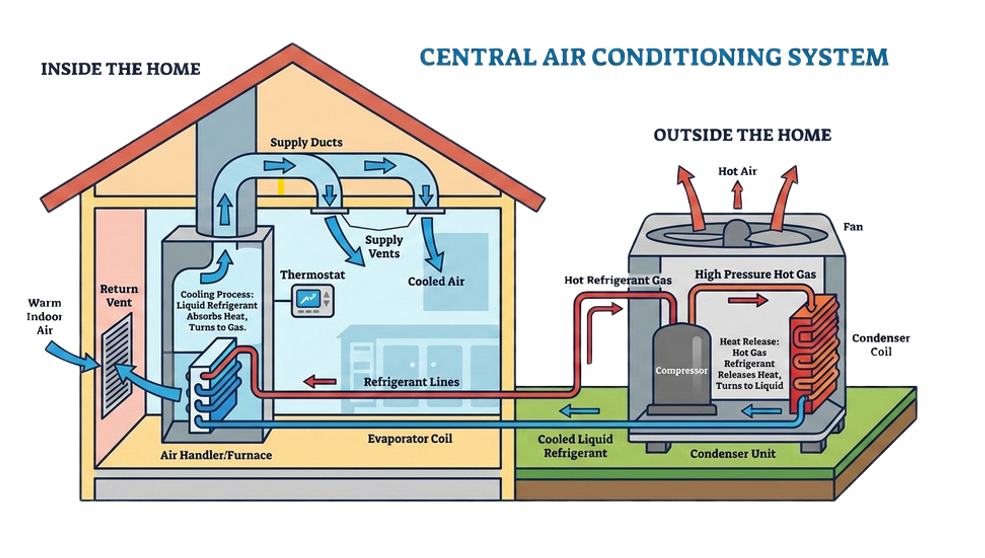
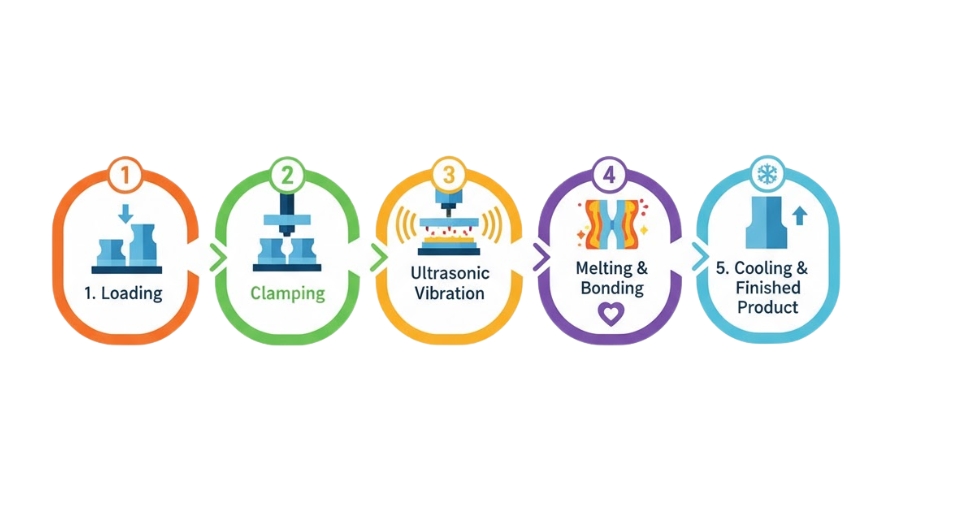
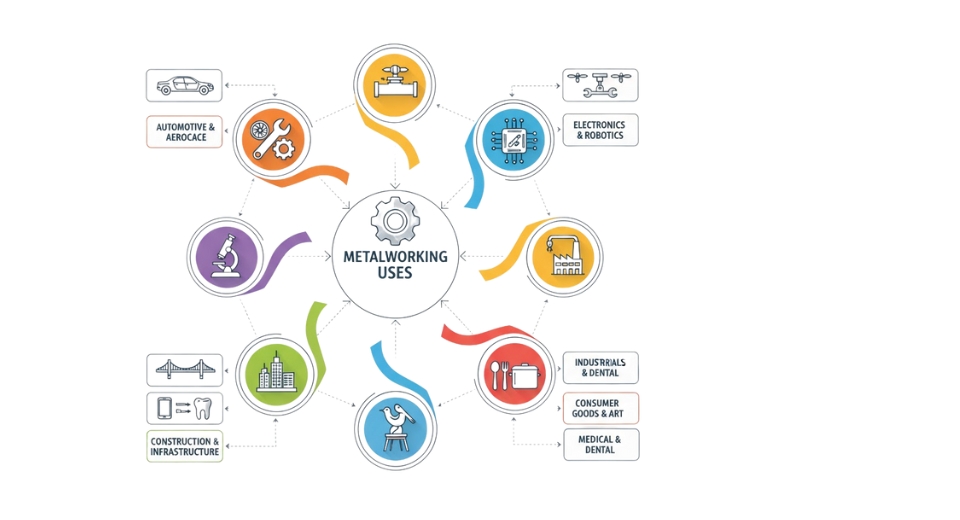
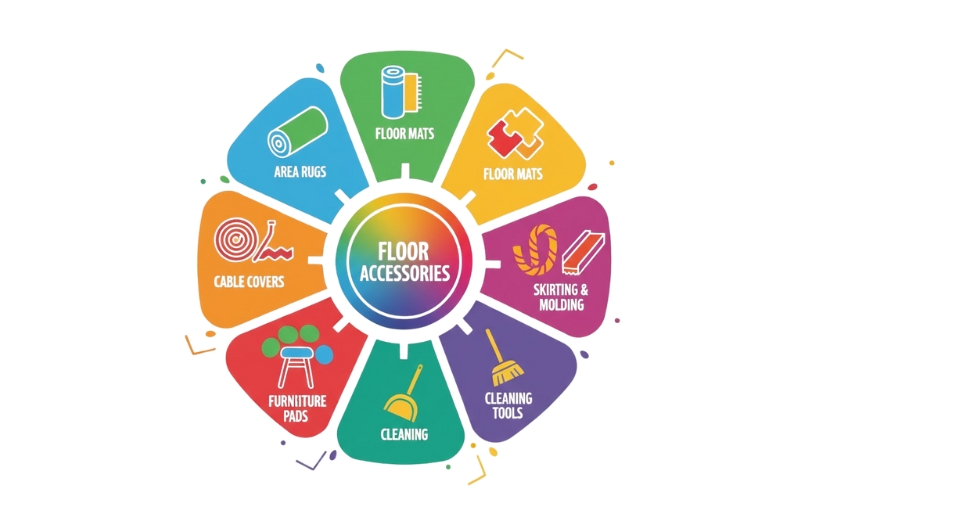

 US: +1 3023308252
US: +1 3023308252






